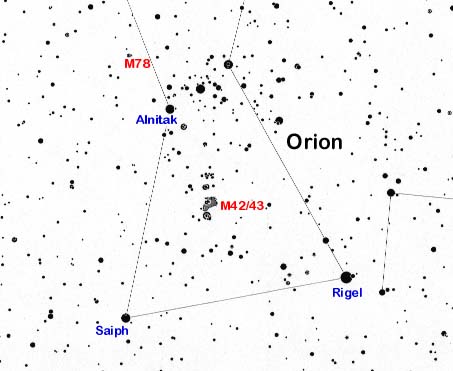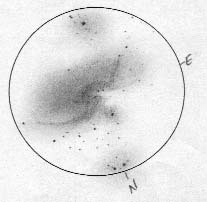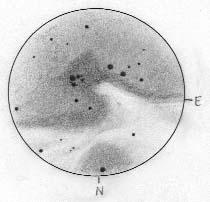Orion defines the winter sky. It is recognized by more people, world-wide, than any other constellation. More bright stars outline the hunter's form than are found in any other constellation. The hunter is also home to the showpiece of the northern sky, M42, the Orion Nebula. M42 resides in the hilt of Orion's sword, about 4 degrees south of Alnilam, the middle star in the hunter's belt. The nebula sits right in the middle of the hilt and is obvious to the unaided eye from a dark sky site. Through a 6X30 or 8X50 finder scope, the Orion Nebula appears bright and unmistakable.
| Winter Sky Tour: M42-The Orion Nebula (Orion) RA: 05h 35.0m / DEC: -05° 25'.0 |

|
 The sketch at left is based on a 36X view. M42 spans 70'x40', more than twice the size of the full Moon. It features expansive wings sweeping east and west. These give the nebula the appearance of an open Chinese fan. The Fish Mouth can be seen as a dark notch in the underside of the nebula. M42 shows a distinct green hue under excellent observing conditions. Messier 43, the nebulous comma patch surrounding the 7th magnitude star immediately to the North, dangles from M42 like an ornament.
The sketch at left is based on a 36X view. M42 spans 70'x40', more than twice the size of the full Moon. It features expansive wings sweeping east and west. These give the nebula the appearance of an open Chinese fan. The Fish Mouth can be seen as a dark notch in the underside of the nebula. M42 shows a distinct green hue under excellent observing conditions. Messier 43, the nebulous comma patch surrounding the 7th magnitude star immediately to the North, dangles from M42 like an ornament. |
|
 The Orion Nebula owes its grand appearance to four young stars known collectively as the Trapezium. These are located south of the Fish Mouth. The brightest member produces enough radiation to cause the surrounding shell of hydrogen gas to glow so brightly that we can see it from a distance of 1,600 light-years. My sketch at right, based on a 190X view, only begins to capture the intricacy of detail visible with moderate aperture. But it provides the clearest evidence that one of the most widely held opinions in deep-sky observing is no more than a myth. It is often said that deep-sky observing is best done using low powers. Poppycock! Low power is great for finding objects and, if the seeing is terrible, may sometimes provide the best view. But a magnification producing a 1-mm to 2-mm exit pupil will often show the most detail.
The Orion Nebula owes its grand appearance to four young stars known collectively as the Trapezium. These are located south of the Fish Mouth. The brightest member produces enough radiation to cause the surrounding shell of hydrogen gas to glow so brightly that we can see it from a distance of 1,600 light-years. My sketch at right, based on a 190X view, only begins to capture the intricacy of detail visible with moderate aperture. But it provides the clearest evidence that one of the most widely held opinions in deep-sky observing is no more than a myth. It is often said that deep-sky observing is best done using low powers. Poppycock! Low power is great for finding objects and, if the seeing is terrible, may sometimes provide the best view. But a magnification producing a 1-mm to 2-mm exit pupil will often show the most detail.
|
URL: http://www.cosmicvoyage.net
Layout, design & revisions © W. D. Ferris
Comments and Suggestions: wdferris1@gmail.com
Revised: February 10, 2002 [WDF]
![]()
![]()

